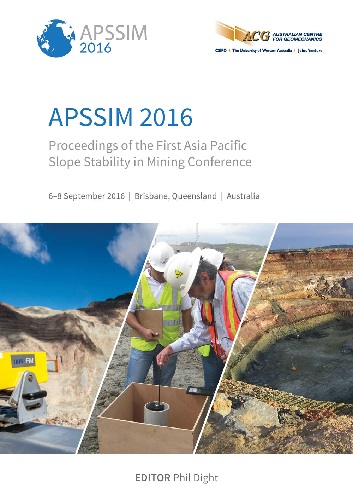Attenuator systems — an old method to deviate rocks but a new testing method for developing a design concept

|
Authors: Glover, J; Wyllie, DC; Bucher, R |
DOI https://doi.org/10.36487/ACG_rep/1604_27_Glover
Cite As:
Glover, J, Wyllie, DC & Bucher, R 2016, 'Attenuator systems — an old method to deviate rocks but a new testing method for developing a design concept', in PM Dight (ed.), APSSIM 2016: Proceedings of the First Asia Pacific Slope Stability in Mining Conference, Australian Centre for Geomechanics, Perth, pp. 435-442, https://doi.org/10.36487/ACG_rep/1604_27_Glover
Abstract:
Rockfall attenuator systems, also known as hybrid rockfall barriers or hanging nets, are a widely applied rockfall mitigation method. Although they are conceptually a straight forward design, to–date, a definitive design guide remains elusive. Among some of the first testing of these systems e.g. Glover et al. 2012, a boarder understanding of the key mechanics, with which they function, has been attained. For example, the process of deflecting rocks to increased ground contact and catching and tangling of the rocks in the attenuator systems has been observed. Nonetheless, these observations remain to be quantified in detail, so they could be developed into a design guide. Addressing this need, a joint testing program is being carried out by Wyllie & Norrish Rock Engineers Ltd. and Geobrugg North America, to measure and validate the performance of rockfall attenuator systems. The preliminary stages of full-scale testing have been conducted at the Nicolum Quarry in Hope, British Columbia, Canada. Tests were conducted using natural rocks of different sizes, <0.5 m³, and steel reinforced concrete cubes, with dimensions of 0.42 and 1.0 m³, dropped into a slope, with a height potential of 60 m, leading to impact with the attenuator netting. The preliminary tests were documented with high speed cameras and load cells measuring the forces in the support ropes. The videos were analysed to determine changes in the rock’s kinetic energy, and the deflection of the attenuator net. The objectives of the tests were to find how to optimise system designs to minimise the impact energy absorbed by the netting and support structure. The maximum impact energy achieved during the preliminary test series was in the order of 600 kJ. Following these initial tests, a second test series was performed in January 2016. Additional to the high speed video and load cell measurements, some experiments involved a novel rock motion logger integrated into the blocks centre of mass. The rock motion logger permitted the rocks accelerations and rotations to be captured during contact with the netting. For the first time, measurements of this kind have been made for attenuators and offer detailed insights into the mechanics of the attenuation process. Further work, in the development of rockfall attenuator systems, is to analyse existing systems, which have been impacted by natural rocks, gaining an estimate of their performance. Alongside these observations, the experimental data is being analysed in detail to refine a new design concept of attenuator barriers. Further results will be given in this paper.
Keywords: rockfall, attenuator systems, rockfall mitigation systems, field testing, design guide
References:
EOTA (European Organisation for Technical Assessment) 2008, Guidelines for European technical approval of falling rock protection kits (ETAG 027), European Organisation for Technical Assessment, Brussels.
Gerber, W 2001, Guideline for the approval of rockfall protection kits, Swiss Agency for Environment, Forest and Landscape (SAEFL) and Swiss Federal Research Institute (WSL), Switzerland.
Glover, J, Denk, M, Bourrier, F, Volkwein, A & Gerber, W 2012, ‘Measuring the kinetic energy dissipation effects of rock fall attenuating systems with video analysis’, in 12th Congress INTERPRAEVENT, vol. 1, pp. 151–160.
Kinovea Motion Analysis Software 2016, Informer Technologies, Inc.
© Copyright 2025, Australian Centre for Geomechanics (ACG), The University of Western Australia. All rights reserved.
View copyright/legal information
Please direct any queries or error reports to repository-acg@uwa.edu.au
View copyright/legal information
Please direct any queries or error reports to repository-acg@uwa.edu.au